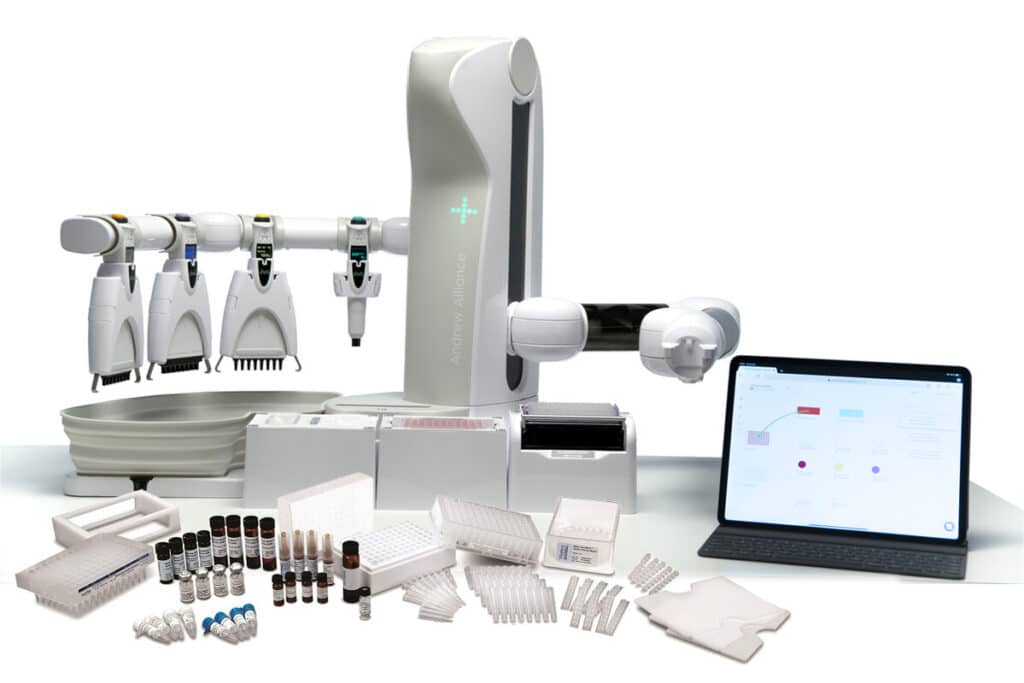
Implementing liquid handling automation for pipetting tasks in a lab is not always an easy undertaking and can be daunting, but it doesn’t have to be. Getting some additional insight from automation users regarding their implementations and the challenges they’ve faced can help paint a better picture for whether or not benchtop liquid handling automation (like the Andrew+ pipetting robot) is right for your lab. This Q&A session with an experienced user of the Andrew+ pipetting robot highlights some of the ideal use cases for using automation in the context of analytical development at Takeda.
« The Andrew+ has just really helped me by making sure that I can set something up and walk away to work on something else or another part of the assay while it’s pipetting. »
- James Vandegrift, Senior Research Associate at Takeda

A: I’m a senior research associate. I work in analytical development and mainly develop methods for analyzing glycans on enzymes and
antibodies. More recently, a lot of that has been developing methods to be automated using the Andrew+.
A: I start immediately in OneLab and I usually find it easier just to go straight to Andrew+… since we have it available I won’t have to
pipette something and I can put that strain on the robot, not me! But especially anything with 96-well plates, I (and I think many
other people) find it just too easy to get lost in the 96 tiny little wells… move one well over and then suddenly everything is wrong!
On top of that, you don’t have a perfect mental log or audit trail of where you pipetted so you might not immediately know the
issue. That’s one of my favorite things about using the Andrew; even if I’m just doing something once, I can immediately (if it has a
96-well plate involved) have it do that pipetting for me because I know that it’s not going to get confused and move one row over.
A: Just time management as a general thing (not a specific challenge for an assay that I’m developing). The Andrew has just really
helped me by making sure that I can set something up and walk away to work on something else or another part of the assay while
it’s pipetting. I also have to redo less stuff because if something goes wrong I don’t have to wonder if I mis-pipetted something.
There’s the time, and then there’s also enzymes and antibodies that are not cheap substances; since that’s most of what I’m working
with, it definitely saves a lot of money if I don’t have to go back and repeat something
A: For me personally, the OneLab software is just incredibly useful because I don’t know how to code so that prevents me from using a
lot of the other automation systems. Since everything is just drag and drop, it’s easy for me to use and then also when other people
want to use it I don’t have to spend a lot of time training them because it’s so intuitive.
A: So, the easy drag and drop functionality is kind of a double-edge sword. I’m able to do what I want 99% of the time, but
occasionally I’ll want it to do something ‘weird’ and I wish there was a ‘developer mode’ where I could just be like ‘pipette this much
into these x,y,z coordinates’ – especially if we have a piece of labware that doesn’t have a Domino already and we don’t feel like
sending it to Waters to have them make a Domino for us which can take some time… That is an option, but if it’s something that I’m
not going to be using long-term, then it’s not necessary.
A: Pretty much any time there’s a 96-well plate involved, even if it’s going to take me an extra couple of minutes to write the method.
These days, I pretty much always use OneLab and Andrew+ as soon as I see a 96-well plate just because I don’t want to have to
worry about missing a well and it’s just so much more traceable than me pipetting by hand. necessary.
James’ challenges have solutions:
The content of this page is directly pulled from the interview session held during the Introductory Episode of the “Using the Connected Lab to Overcome Your Challenges” Webinar series.
